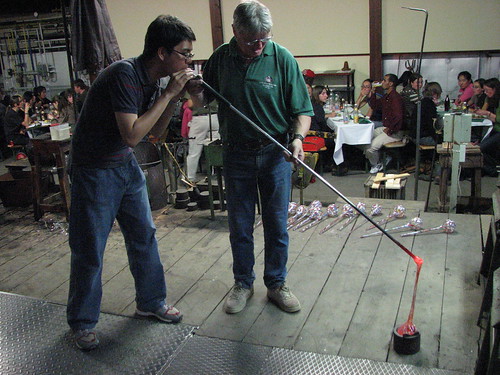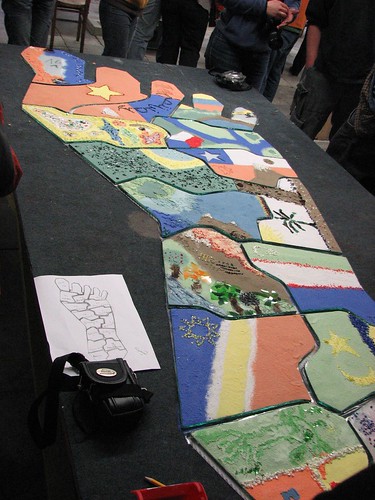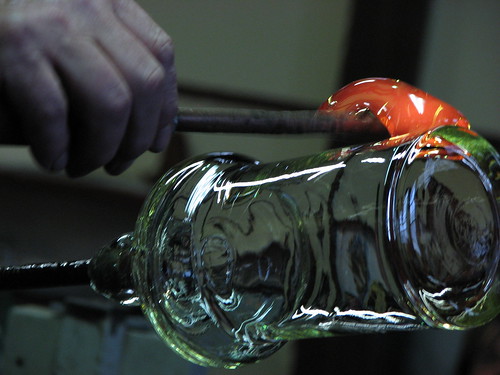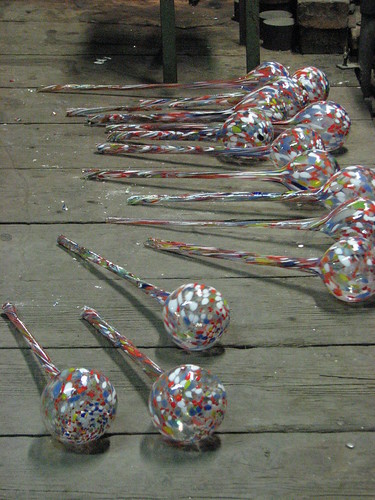 Continued from Go4BioDiv: dwelling in the forest
Continued from Go4BioDiv: dwelling in the forest
The biting cold on the fourth day woke me up from my deep slumber. To take a look if morning has broken, I pulled down my sleeping bag, and as I did so, a ball of called air hit my face and displaced the warm air trapped in it. I pulled its flap over my head, and curled inside my synthetic cocoon. My five-star tent apparently wasn't warm enough to shield us from the cold temperature, especially when it dipped below ten degrees early in the morning. We were partly to blame, when no one bothered to make the fire the night before.
After our orientation workshop in the morning, a bus took us to the little town of Frauenau. The town once teeming from glass industry has turned into a meek one. An old glass factory greeted us from where the bus dropped us off. Despite its intact facade, we were not allowed to go inside because of the deteriorating structure. I could imagine scores of this kind of factory, logs constantly being delivered and hauled to fuel the furnace, while glass-blowers worked out their pipes and pinchers to come up with their glass masterpieces once upon a time.
This is also where we met one of the glass artists that popularized the art in Frauenau, and probably in the world, Erwin Eisch. Glass and visual artists from all over the world embark on a pilgrimage to this town to hone their craft under his guidance.
The shards of glass recovered from ruins in different parts of the world are now housed in the Glass Museum walked us through the history of glass, and how it made its way to this part of the world. Glass of all colors, shapes, and sizes stood still on the shelves as if frozen in time. A special favorite is a wall of glass formed from stacking together a total of 8,000 glass wines.
After the tour, we visited Mr. Eisch's studio that was typical of what I expected from an artist and his workplace: an air of eccentricity and distance, streaks of paint on the floor and walls, and a handful of unfinished paintings. I asked him where he gets his inspirations, and he delved into the beauty of the human body and its purity. We poured out the inspiration we absorbed from the museum to the glass art we had to come up with- our symbol of the ecological footprint. The glass cut into jigsaw puzzle pieces formed a giant foot. Each piece represented one country the participants of which had to decorate and apply colors of their own fancy. It was a test of patience and dexterity in gently tipping the little strainers that held and sifted the colored powder which sprayed on the transparent glass. One false move could result to a stain on the other design which could be difficult to remedy. We also got smaller "feet" to decorate and bring home as souvenirs and gifts. We all anticipated to see the result of our hard work, although this we had to wait a couple of days to see our little feet, and the giant foot we would see much later in Bonn.
We poured out the inspiration we absorbed from the museum to the glass art we had to come up with- our symbol of the ecological footprint. The glass cut into jigsaw puzzle pieces formed a giant foot. Each piece represented one country the participants of which had to decorate and apply colors of their own fancy. It was a test of patience and dexterity in gently tipping the little strainers that held and sifted the colored powder which sprayed on the transparent glass. One false move could result to a stain on the other design which could be difficult to remedy. We also got smaller "feet" to decorate and bring home as souvenirs and gifts. We all anticipated to see the result of our hard work, although this we had to wait a couple of days to see our little feet, and the giant foot we would see much later in Bonn. As if we haven't had enough of our glass journey, we made a short drive to Poschinger, the oldest glass manufacturing factory in the world. Here we had our typical Bavarian dinner- not of glass, but of a meat-lovers' haven. Slabs and slices of different kinds of meat were the order of the day. Roasted or cold cuts, you got it. I met again the infamous sauerkraut, which I had vowed not to touch again after having mistaken it for German pasta (what was I thinking then?) and dabbed my plate a generous serving the first time I encountered it. I made a compromise with the less threatening yet just as adventurous Knoedel.
As if we haven't had enough of our glass journey, we made a short drive to Poschinger, the oldest glass manufacturing factory in the world. Here we had our typical Bavarian dinner- not of glass, but of a meat-lovers' haven. Slabs and slices of different kinds of meat were the order of the day. Roasted or cold cuts, you got it. I met again the infamous sauerkraut, which I had vowed not to touch again after having mistaken it for German pasta (what was I thinking then?) and dabbed my plate a generous serving the first time I encountered it. I made a compromise with the less threatening yet just as adventurous Knoedel.
Before we ate our carnivorous feast, Mr. Poschinger himself welcomed us to his ancestral domain and one of the glass-blowers gave us a demonstration. The gigantic oven in the middle of the spacious factory doubled as a heater. The artisan worked with ease in dipping the metal pipe in the furnace. He twisted the pipe as if skewering a pig to collect some molten glass, took it out, pinched the still-soft glass here and there. As the tail end of the glass dripped, he caught it with his pliers, made a few more pokes and twists and voila! a kitten cast in glass. As if discovering his steak was medium rare, he put it again in the oven. This, he explained to us, is done to gradually cool the glass, otherwise, it will easily break from the instant cooling. He was like a magician with a metal pipe as his staff, instantly turning hot water into sculptured ice. We made our bee line for the food, while others tried their hand, rather their mouth, in glass-blowing. After working hard the entire time as we devoured our meal, we gave the glass artist some Trinkgeld (like a tip) for his patience. It is not simply some few coins, but bills as well of different currencies from our international group.
We made our bee line for the food, while others tried their hand, rather their mouth, in glass-blowing. After working hard the entire time as we devoured our meal, we gave the glass artist some Trinkgeld (like a tip) for his patience. It is not simply some few coins, but bills as well of different currencies from our international group.
That night, we went home tired from all the days' activities, and brought with us a glimpse of the town's history of a thriving glass industry. And for some reason, these left me glassy-eyed.
(to be continued...)
More photos in my flickr page
Saturday, June 21, 2008
Go4BioDiv: glass-blowing in Frauenau
Subscribe to:
Post Comments (Atom)





No comments:
Post a Comment